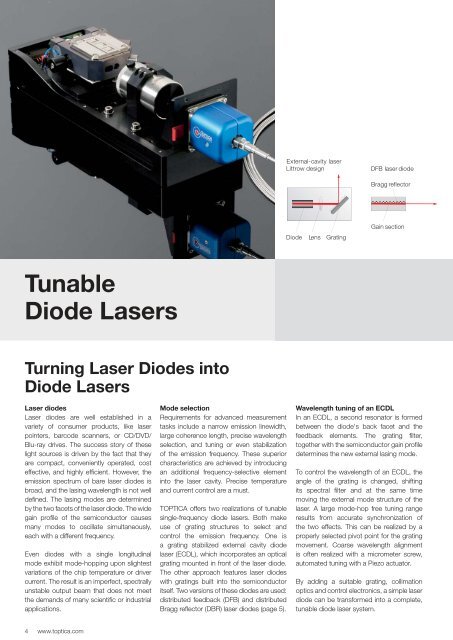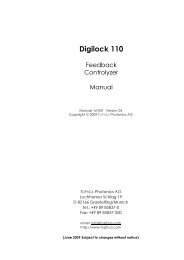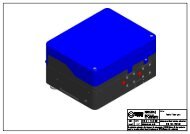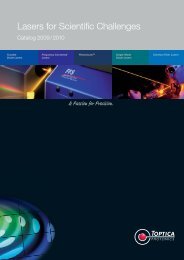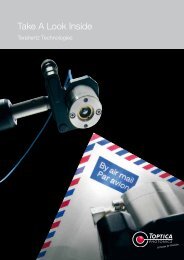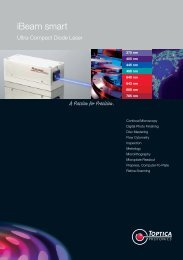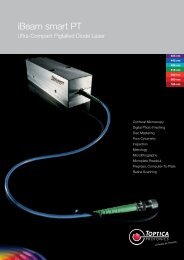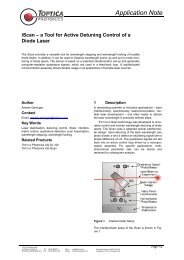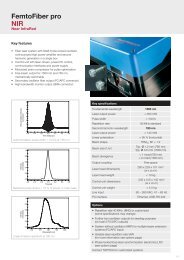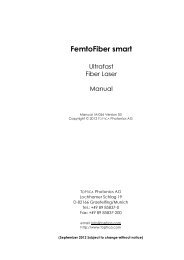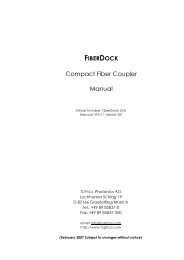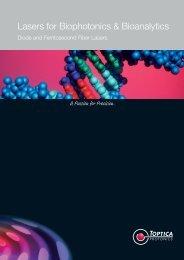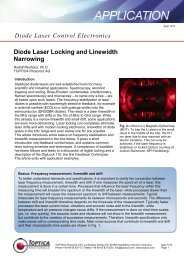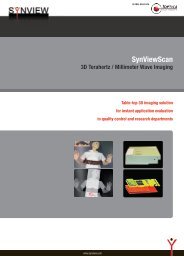You also want an ePaper? Increase the reach of your titles
YUMPU automatically turns print PDFs into web optimized ePapers that Google loves.
<strong>Tunable</strong><br />
<strong>Diode</strong> <strong>Lasers</strong><br />
Turning Laser <strong>Diode</strong>s into<br />
<strong>Diode</strong> <strong>Lasers</strong><br />
Laser diodes<br />
Laser diodes are well established in a<br />
variety of consumer products, like laser<br />
pointers, barcode scanners, or CD/DVD/<br />
Blu-ray drives. The success story of these<br />
light sources is driven by the fact that they<br />
are compact, conveniently operated, cost<br />
effective, and highly effi cient. However, the<br />
emission spectrum of bare laser diodes is<br />
broad, and the lasing wavelength is not well<br />
defi ned. The lasing modes are determined<br />
by the two facets of the laser diode. The wide<br />
gain profi le of the semiconductor causes<br />
many modes to oscillate simultaneously,<br />
each with a different frequency.<br />
Even diodes with a single longitudinal<br />
mode exhibit mode-hopping upon slightest<br />
variations of the chip temperature or driver<br />
current. The result is an imperfect, spectrally<br />
unstable output beam that does not meet<br />
the demands of many scientifi c or industrial<br />
applications.<br />
4 www.toptica.com<br />
Mode selection<br />
Requirements for advanced measurement<br />
tasks include a narrow emission linewidth,<br />
large coherence length, precise wavelength<br />
selection, and tuning or even stabilization<br />
of the emission frequency. These superior<br />
characteristics are achieved by introducing<br />
an additional frequency-selective element<br />
into the laser cavity. Precise temperature<br />
and current control are a must.<br />
TOPTICA offers two realizations of tunable<br />
single-frequency diode lasers. Both make<br />
use of grating structures to select and<br />
control the emission frequency. One is<br />
a grating stabilized external cavity diode<br />
laser (ECDL), which incorporates an optical<br />
grating mounted in front of the laser diode.<br />
The other approach features laser diodes<br />
with gratings built into the semiconductor<br />
itself. Two versions of these diodes are used:<br />
distributed feedback (DFB) and distributed<br />
Bragg refl ector (DBR) laser diodes (page 5).<br />
Wavelength tuning of an ECDL<br />
In an ECDL, a second resonator is formed<br />
between the diode's back facet and the<br />
feedback elements. The grating fi lter,<br />
together with the semiconductor gain profi le<br />
determines the new external lasing mode.<br />
To control the wavelength of an ECDL, the<br />
angle of the grating is changed, shifting<br />
its spectral fi lter and at the same time<br />
moving the external mode structure of the<br />
laser. A large mode-hop free tuning range<br />
results from accurate synchronization of<br />
the two effects. This can be realized by a<br />
properly selected pivot point for the grating<br />
movement. Coarse wavelength alignment<br />
is often realized with a micrometer screw,<br />
automated tuning with a Piezo actuator.<br />
By adding a suitable grating, collimation<br />
optics and control electronics, a simple laser<br />
diode can be transformed into a complete,<br />
tunable diode laser system.
Fabry-Perot and Anti-Refl ection<br />
Coated Laser <strong>Diode</strong>s<br />
FP diodes — high power at a low cost<br />
In TOPTICA's DL 100, an ECDL in Littrow<br />
design, both Fabry-Perot (FP) diodes and<br />
anti refl ection coated (AR) diodes can<br />
be used. FP diodes are mass-produced,<br />
available at numerous wavelengths, and are<br />
optimized for maximum output powers. In<br />
addition, they are relatively cheap. With FP<br />
diodes, the internal resonator of the diode<br />
functions like an etalon, attenuating certain<br />
external modes, and therefore participating<br />
in the selection of the external mode.<br />
The effect of the internal resonator is less<br />
pronounced when an AR coating is added<br />
on the output facet. AR diodes do not lase<br />
without external feedback. The AR coating<br />
improves coarse and mode-hop free tuning<br />
of an ECDL and allows for more stable<br />
single-mode operation. TOPTICA's DL pro<br />
lasers therefore feature AR diodes.<br />
AR diodes for best performance<br />
The internal resonator of both FP and<br />
AR diodes can be synchronized with the<br />
grating movement by changing the diode<br />
current simultaneously. This “feed forward”<br />
mechanism moves the internal mode<br />
structure of the laser diode along with the<br />
external modes, permitting larger modehop<br />
free tuning.<br />
DFB & DBR <strong>Diode</strong> <strong>Lasers</strong><br />
Laser diodes with internal grating<br />
Distributed Feedback (DFB) and Distributed<br />
Bragg Refl ector (DBR) laser diodes feature<br />
a grating structure incorporated in the<br />
semiconductor chip. The grating restricts the<br />
laser emission to a single longitudinal mode<br />
and thus determines the lasing wavelength.<br />
In a DFB laser, the grating is integrated into<br />
the active region (“gain section”) of the diode.<br />
In a DBR laser, the grating (“Bragg section”)<br />
is separated from the gain region. An<br />
additional “phase section” serves to maintain<br />
mode-hop free resonance conditions during<br />
a wavelength change.<br />
Frequency tuning is accomplished by<br />
thermally or electrically varying the grating<br />
pitch. Thermal tuning offers extremely large<br />
mode-hop free scans of hundreds of GHz.<br />
Electric modulation, on the other hand, can<br />
be employed for fast frequency modulation<br />
over a smaller range (several tens of GHz @<br />
kHz to MHz modulation frequencies).<br />
ECDL or DFB?<br />
Whether to choose an<br />
external cavity diode laser or<br />
a DFB/DBR laser depends<br />
on the individual application.<br />
Contact the TOPTICA experts<br />
to fi nd the best solution for<br />
your needs. DFB diodes do<br />
not yet offer the wavelength<br />
range accessible by Littrow<br />
ECDLs. <strong>Tunable</strong>, narrow-band<br />
emission in the blue or red spectral range<br />
is the realm of external-cavity systems.<br />
An ECDL is also the preferred choice for<br />
applications that require a broad coarse<br />
tuning range, or an ultra-narrow linewidth<br />
(1 MHz or below).<br />
The main advantage of a DFB laser is<br />
its extremely large continuous tuning<br />
range. Mode-hop free scans of several<br />
nanometers are routinely attained. Typical<br />
DFB laser applications are gas sensing,<br />
Important specifi cations for FP- or ARbased<br />
ECDLs are the output power available<br />
from the stabilized diode, the attainable<br />
wavelength range, and the mode-hop free<br />
tuning range. TOPTICA also sells laser<br />
diodes individually, and the diodes available<br />
from stock, together with their specifi cations,<br />
are listed in our regularly updated stock list<br />
at www.laser-diodes.com.<br />
Laser diode with (red) and without<br />
(blue) external grating feedback. The<br />
left graph shows an FP diode, the right<br />
graph an AR diode.<br />
Schematics of DFB and DBR laser diodes.<br />
phase shifting interferometry, or the<br />
generation of tunable cw Terahertz<br />
radiation. The mechanical design of a DFB<br />
laser comprises no alignment-sensitive<br />
optical components, making these lasers<br />
particularly attractive for applications in<br />
rough industrial environments.<br />
www.toptica.com 5<br />
<strong>Tunable</strong> <strong>Diode</strong> <strong>Lasers</strong> Frequency Converted <strong>Lasers</strong> Photonicals TM Single-Mode <strong>Diode</strong> <strong>Lasers</strong> Ultrafast Fiber <strong>Lasers</strong>
<strong>Tunable</strong> <strong>Diode</strong> <strong>Lasers</strong><br />
Littrow and Littman Confi guration<br />
Compact and robust Littrow setup<br />
The most common types of ECDLs<br />
are the so-called Littrow and Littman<br />
confi gurations. In both cases, a grating is<br />
used to selectively refl ect a small range of<br />
the diode's emission spectrum back into<br />
the laser chip. This optical feedback forces<br />
the diodes into single-frequency operation.<br />
In Littrow confi guration, the fi rst order<br />
beam from the grating is directly refl ected<br />
into the diode. In Littman confi guration, by<br />
contrast, the fi rst diffraction order is fi rst<br />
refl ected from a mirror. It passes the grating<br />
a second time and is then sent back into<br />
the laser diode. In both setups, the main<br />
contribution to the technical linewidth are<br />
6 www.toptica.com<br />
usually electronic noise, acoustic noise<br />
and vibrations that affect the cavity length.<br />
In practical operation, the compact and<br />
more robust Littrow cavity often shows a<br />
narrower linewidth.<br />
Highest power from Littrow lasers<br />
The Littrow setup has further advantages.<br />
As the laser light refl ects off the grating only<br />
once, losses into other diffraction orders<br />
do not occur. The output power of Littrow<br />
lasers is thus considerably higher than that<br />
of comparable Littman setups. Moreover,<br />
Littrow lasers can be operated with both<br />
standard Fabry-Perot (FP) diodes and antirefl<br />
ection (AR) coated laser diodes, while the<br />
Littman design usually employs AR coated<br />
diodes. FP diodes provide higher powers,<br />
encompass a broader wavelength range<br />
and are usually less expensive. However,<br />
TOPTICA also integrates AR coated diodes<br />
when large tunability is required, and when<br />
power plays a secondary role.<br />
The mode-hop-free tuning range of Littrow<br />
lasers can be greatly enhanced by adding<br />
a “feed forward” current modulation (see<br />
page 5). The marginal angular change of<br />
the output beam apparent with Littrow<br />
cavities can be effectively compensated for<br />
by a beam steering mirror rotated in parallel<br />
with the grating.<br />
Mode selection in ECDLs. The<br />
back facet and the feedback<br />
elements form the external<br />
resonator. The oscillating mode<br />
is selected not only by these<br />
elements and the semiconductor<br />
gain, but also by the internal<br />
modes (etalon) of the diode.
Frequency noise<br />
High stability and narrow linewidth are<br />
often key requirements for scientifi c diode<br />
lasers. Theoretically, the linewidth of grating<br />
stabilized diode lasers is given by the<br />
Schawlow-Townes formula and therefore<br />
very narrow. In reality, however, a number<br />
of processes and disturbances have an<br />
effect on the laser frequency. Laser current<br />
noise for example causes fl uctuations of<br />
the refractive index within the laser diode<br />
itself, and changes the overall optical length<br />
of the laser resonator. Acoustic noise and<br />
vibrations have a direct infl uence on the<br />
mechanical length of an external resonator,<br />
while temperature and air pressure<br />
fl uctuations cause frequency drifts by<br />
changing the refractive index of air.<br />
Linewidth and drift<br />
Processes that are faster than the laser<br />
frequency measurement itself, add to the<br />
laser's technical linewidth, while slower<br />
processes will cause a frequency drift<br />
between successive measurements. As<br />
fast measurement techniques will not reveal<br />
slower drift effects on the linewidth, it is<br />
important to always note the time scale of<br />
the measurement when specifying linewidth<br />
values.<br />
Main causes for frequency variations and their respective time scales.<br />
Linewidth measurement<br />
TOPTICA uses different ways to measure<br />
laser linewidths. For fast measurements,<br />
a delayed self-heterodyne technique is<br />
employed. The laser beam is split into two<br />
probe beams, one of which is frequencyshifted<br />
by an acousto-optical modulator<br />
and delayed utilizing a 1 km long fi ber.<br />
Subsequently, the beams are re-combined<br />
on a fast photo detector, the output of which<br />
is connected to an RF spectrum analyzer.<br />
The fi ber line corresponds to a time delay<br />
of 5 µs. Frequency fl uctuations within this<br />
time contribute to the beat note, the width<br />
of which is approximately twice the laser‘s<br />
linewidth.<br />
Linewidth measurements on longer time<br />
scales are accomplished by measuring the<br />
beat width of two identical lasers with a fast<br />
detector and an RF spectrum analyzer (sub<br />
Hz .. 100 MHz), by using a Fabry-Perot<br />
interferometer (MHz .. GHz, see page 49),<br />
or by directly determining the coherence<br />
length with a Michelson interferometer.<br />
Linewidth and coherence length<br />
Laser linewidth and coherence length are<br />
linked by an inverse proportionality. The<br />
numerical factor depends on the spectral<br />
line shape. For a Gaussian spectral profi le,<br />
the coherence length is 132 m / (linewidth<br />
in MHz).<br />
Coherence coverage of more than<br />
12 decades.<br />
Delayed self-heterodyne<br />
linewidth measurement.<br />
www.toptica.com 7<br />
<strong>Tunable</strong> <strong>Diode</strong> <strong>Lasers</strong> Frequency Converted <strong>Lasers</strong> Photonicals TM Single-Mode <strong>Diode</strong> <strong>Lasers</strong> Ultrafast Fiber <strong>Lasers</strong>
pro Technology<br />
Stability and Ease of Use<br />
DL pro, TA pro, DL/TA-SHG/FHG pro<br />
Modern physics experiments get more and<br />
more involved with an increasing number<br />
of instruments and especially laser sources<br />
running simultaneously. Uncovering a<br />
faint signal never seen before from the<br />
ever present noise background requires<br />
highest performance, a love of tiny detail,<br />
dependability and trust in workmanship. At<br />
TOPTICA, we come from laboratories like<br />
our customers', and we understand what it<br />
means to spend long nights relying on laser<br />
technology for collecting data. Only the<br />
best tools are good enough to contribute to<br />
such a competitive fi eld. With this in mind,<br />
TOPTICA continues to follow a strategy to<br />
develop a second generation of its scientifi c<br />
instrumentation and make it broadly<br />
available. We are now excited to introduce<br />
the “pro” Technology.<br />
8 www.toptica.com<br />
Our aim at TOPTICA is to develop lasers,<br />
that are the best of their class, more stable,<br />
more reliable and at the same time easier<br />
to use. The DL pro, a revolutionary new<br />
external cavity diode laser, introduced in<br />
2007, launched TOPTICA‘s pro series with<br />
great success. This laser was designed<br />
with ultimate stability in mind – in particular<br />
stability against temperature changes and<br />
acoustic disturbances. The DL pro has<br />
quickly become the heart of TOPTICA's<br />
diode laser activities, and we have been<br />
working hard to extend the design<br />
principles also to other laser sources. The<br />
DL pro‘s narrow linewidth and robustness<br />
to temperature changes and vibrations are<br />
unmatched by any other commercial diode<br />
laser. Together with our high end laboratory<br />
driver, control and locking electronics it has<br />
convinced many leaders in the fi eld to trust<br />
in pro technology.<br />
The next milestones are the pro versions of<br />
amplifi ed (TA pro) and frequency converted<br />
(DL/TA-SHG/FHG pro) tunable diode laser.<br />
Paying attention to every little detail these<br />
already established products have acquired<br />
yet another edge. Last but not least, the pro<br />
technology concept at TOPTICA has also<br />
been incorporated into our line of ultrafast<br />
lasers, emerging as the FemtoFiber pro.<br />
It completes the line of scientifi c “pro”<br />
laser products at TOPTICA. The pro series<br />
ensures technological leadership for modern<br />
physics experiments for the years to come<br />
and gives you the edge to put you ahead of<br />
the crowd.<br />
pro technology stands for:<br />
� Stability<br />
� Ease of use<br />
� Thermal and acoustic ruggedness<br />
� Hands-off operation wherever possible<br />
� Flexure joints wherever expedient
DL pro<br />
Ultra-Stable Widely <strong>Tunable</strong> Littrow Laser<br />
As the fi rst laser of the pro series, the DL<br />
pro has already demonstrated how much<br />
even a well-established laser like the DL<br />
100 can be further improved.<br />
Main advantages<br />
For the user the main advantages are<br />
large mode-hop free tuning, alignment free<br />
operation, and highest acoustic and thermal<br />
stability of any ECDL on the market. The<br />
result is most reliable and most convenient<br />
operation for high end laboratory work.<br />
To achieve this ultimate performance<br />
accompanied by ease of use, the DL pro<br />
mechanics possesses degrees of freedom<br />
exactly where they are needed. Coarse and<br />
fi ne tuning have been skillfully separated:<br />
Coarse tuning is performed by a well<br />
defi ned rotation of the grating, that precisely<br />
selects any requested wavelength within<br />
the complete diode gain spectrum. Mode<br />
hop free tuning is realized by a system of<br />
robust fl exure joints that requires only tiny<br />
adjustments. It rotates the laser's grating<br />
around the perfect “virtual” pivot point<br />
(international patent pending).<br />
The compact and stable external cavity<br />
resonator has its fi rst mechanical resonance<br />
above 4 kHz — one reason for its superior<br />
acoustic stability. Special care has been<br />
taken in choosing dimensions and materials<br />
to reduce frequency drifts due to variations of<br />
the ambient temperature. Notwithstanding<br />
its stability, the DL pro is easy to align. The<br />
experienced user can even exchange the<br />
laser diode himself.<br />
DL pro Piezo transfer function. The<br />
fi rst acoustic resonance is above<br />
4 kHz.<br />
Selected antirefl ection-coated (AR)<br />
diodes<br />
In the DL pro only carefully selected AR<br />
coated laser diodes are used. It is available<br />
at four standard wavelengths, providing<br />
most stable single-mode operation and<br />
easy handling. Other wavelengths are<br />
available on request.<br />
Motorization<br />
The DL pro can also be equipped with a<br />
motor for wavelength selection. The user<br />
can then choose the wavelength using<br />
coarse or fi ne dials on the control box or<br />
via computer control using an RS 232<br />
interface. The wavelength can be set to any<br />
value within the gain bandwidth of the diode<br />
with an accuracy of approximately 0.2 nm<br />
by software commands. For further details<br />
on the motorized wavelength selection<br />
option MOT/DL pro, please contact your<br />
local TOPTICA representative.<br />
Measured beat signal of two free running<br />
DL pro 780 averaged over 10 centered<br />
sweeps with a sweep time of 100 ms<br />
each. The resulting beat width is 308 kHz,<br />
the linewidth approx. 150 kHz.<br />
Laser frequency response to a 10 K air<br />
temperature change (laser and electronics<br />
inside climate chamber).<br />
∆<br />
DL pro — the ultimate Littrow<br />
diode laser.<br />
First class optomechanic (patent pending).<br />
Key features<br />
· Ultra-stable mechanics<br />
· Best Littrow design available<br />
· Optimized virtual pivot point<br />
· 30 – 50 GHz mode-hop free tuning<br />
· Convenient and simple coarse tuning<br />
up to 95 nm<br />
Alignment free coarse tuning over<br />
tens of nm.<br />
www.toptica.com 9<br />
<strong>Tunable</strong> <strong>Diode</strong> <strong>Lasers</strong> Frequency Converted <strong>Lasers</strong> Photonicals TM Single-Mode <strong>Diode</strong> <strong>Lasers</strong> Ultrafast Fiber <strong>Lasers</strong>
<strong>Tunable</strong> <strong>Diode</strong> <strong>Lasers</strong><br />
Standard Systems DL pro<br />
Wavelengths and Specifi cations<br />
Specifi cations<br />
10 www.toptica.com<br />
DL pro 780 DL pro 850 DL pro 940 DL pro 1040<br />
Wavelength range 765 – 795 nm 815 – 855 nm 915 – 985 nm 980 – 1075<br />
Max. output power 30 – 80 mW 30 – 80 mW 30 – 80 mW 20 – 50 mW<br />
Mode-hop free tuning 30 – 50 GHz 30 – 50 GHz 30 – 50 GHz 30 – 50 GHz<br />
Typical linewidth (5 µs) 100 kHz 100 kHz 100 kHz 100 kHz<br />
ASE (dB) < -35 .. -55 dB < -35 .. -55 dB < -35 .. -55 dB < -35 .. -55 dB<br />
For further specifi cations and available options, please see pages 13 - 15.<br />
Normalized spectra of DL pro 780<br />
at three different wavelengths.<br />
Normalized spectra of DL pro 940<br />
at three different wavelengths.<br />
Normalized spectra of DL pro 850<br />
at three different wavelengths.<br />
Normalized spectra of DL pro 1040<br />
at three different wavelengths.
DL 100<br />
External Cavity <strong>Diode</strong> Laser in Littrow Design<br />
Principle of operation<br />
The excellent performance of the established<br />
DL 100 results from its Littrow type externalcavity<br />
laser setup in a very rugged design.<br />
Micrometer screws allow for coarse manual<br />
tuning, while precise mode-hop free scans<br />
are driven by a Piezo actuator. Lockable<br />
x/y/z adjustments together with metal<br />
fl exures provide rigid and repeatable<br />
control of both the laser beam collimation<br />
and the feedback of the grating. The laser<br />
resonator is thermally stabilized by means of<br />
a Peltier cooler, connected to the DTC 110<br />
<strong>Diode</strong> Temperature Control. Ultra low<br />
noise operation of the DL 100 is achieved<br />
by means of the <strong>Diode</strong> Current Control<br />
DCC 110. In addition, TOPTICA offers a<br />
variety of electronic regulator modules to<br />
stabilize the laser frequency in demanding<br />
scientifi c and industrial applications (for a full<br />
description see pages 30 - 43).<br />
Modular design<br />
The DL 100 diode laser head comprises a<br />
mounting base which serves as a heat sink,<br />
a temperature sensor and Peltier cooler for<br />
active temperature control, a laser base<br />
plate, a laser diode holder with a collimator<br />
and a grating mount featuring a Piezo<br />
actuator for precise tuning. The laser diode<br />
itself can be easily exchanged by replacing<br />
the diode holder without dismantling the<br />
setup. The DL 100 is available with AR and<br />
FP diodes. FP diodes normally deliver higher<br />
power at lower cost, while AR coated didoes<br />
Linewidth of DL 100, determined with<br />
a delayed self-heterodyne beat setup<br />
(integration time 5 µs). The FWHM of<br />
the beat signal is equal to two times the<br />
laser linewidth (450 kHz).<br />
offer wider tuning, more stable single-mode<br />
behaviour and narrowest linewidths.<br />
The control and supply units are designed as<br />
modular plug-ins which can be combined to<br />
meet any application requirement. Further<br />
modules like Scan Controls, Lock-In, PID<br />
regulators and Pound-Drever-Hall detectors<br />
complete the modular electronic setup.<br />
Hands-on setup<br />
The DL 100 has evolved in research<br />
laboratories and therefore offers multiple<br />
features and the necessary versatility for<br />
a changing environment. For instance, all<br />
important alignment parameters are easily<br />
accessible from above and are adjustable<br />
by lockable micrometer screws. If an OEM<br />
application requires a fi xed laser setup with<br />
limited user access, TOPTICA can also<br />
provide a “hands-off” version of their lasers.<br />
Reasonably priced<br />
The DL 100 <strong>Diode</strong> Laser Series with the<br />
<strong>Diode</strong> Control Unit DC 110, the <strong>Diode</strong> Current<br />
Control DCC 110 and the <strong>Diode</strong> Temperature<br />
Control DTC 110 is your complete step into<br />
the “World of <strong>Diode</strong> <strong>Lasers</strong>”. Due to the<br />
strong emphasis on passive mechanical<br />
stability, low thermal expansion and drifts,<br />
an excellent performance of the DL series<br />
can be guaranteed at an affordable price.<br />
DL 100 frequency sweep over four Rb<br />
absorption lines (red), utilizing feed<br />
forward. FPI transmission peaks (blue,<br />
FSR 1 GHz) are shown for reference.<br />
DL 100 — one of the most common<br />
lasers in research laboratories.<br />
Key features<br />
· Widest wavelength coverage<br />
375 .. 1670 nm<br />
· Highest power up to 300 mW<br />
· Coarse tuning up to 110 nm<br />
· Mode-hop free tuning up to 30 GHz<br />
· Single-frequency operation<br />
· Free running linewidth<br />
100 kHz .. 1 MHz (5 µs)<br />
· AR & FP diodes<br />
· Regularly updated diode stock list:<br />
www.laser-diodes.com<br />
· Options: isolators, beam shaping, fiber<br />
coupling, high frequency modulation, ...<br />
www.toptica.com 11<br />
<strong>Tunable</strong> <strong>Diode</strong> <strong>Lasers</strong> Frequency Converted <strong>Lasers</strong> Photonicals TM Single-Mode <strong>Diode</strong> <strong>Lasers</strong> Ultrafast Fiber <strong>Lasers</strong>
<strong>Tunable</strong> <strong>Diode</strong> <strong>Lasers</strong><br />
DL DFB<br />
<strong>Diode</strong> <strong>Lasers</strong> with Largest Mode-hop Free Tuning Range<br />
DL DFB laser heads with driving<br />
electronics (series DC 110).<br />
Key features<br />
· Every wavelength between 760 nm and<br />
3000 nm available<br />
· High output power up to 150 mW<br />
· Mode-hop free tuning up to 1400 GHz<br />
(4 nm)<br />
· Single-frequency operation, linewidth<br />
typ. 0.5 .. 4 MHz (5 µs)<br />
· Reliable operation even in harsh<br />
environments (no alignment-sensitive<br />
optomechanics)<br />
· Optional: high-frequency modulation,<br />
optical isolation, fiber coupling<br />
· Regularly updated diode stock list:<br />
www.laser-diodes.com<br />
12 www.toptica.com<br />
Wide wavelength range 760 .. 3000 nm<br />
TOPTICA's DL DFB lasers offer wide<br />
tunability, narrow linewidth and high output<br />
power in a compact and very rugged setup.<br />
Systems can be provided at any wavelength<br />
between 760 and 3000 nm. A large variety<br />
of wavelengths is usually available from<br />
stock (including 780 nm, 785 nm, 795 nm,<br />
852 nm, 895 nm, 935 nm and 1064 nm),<br />
but customized wavelengths can be realized<br />
even in low quantities and within short lead<br />
times.<br />
The absence of any alignment-sensitive<br />
opto-mechanical components ensures high<br />
long-term stability and reliability. The DL DFB<br />
therefore opens new possibilities for projects<br />
that require automated operation, or even<br />
for airborne experiments.<br />
Frequency tuning of TOPTICA's DL DFB<br />
lasers is accomplished by changing either<br />
the chip temperature (frequency change<br />
ca. 25 GHz/K) or the operating current<br />
(frequency change 1-5 GHz/mA). Thermal<br />
tuning achieves extremely large mode-hop<br />
free scan ranges, electric tuning is favorable<br />
for rapid modulation and frequency<br />
stabilization tasks.<br />
Thermal frequency tuning of<br />
a DL DFB. Linearized scans<br />
can be accomplished with<br />
TOPTICA's iScanTM technology<br />
(see pages 42 - 43).<br />
Frequency and linewidth control<br />
The high sensitivity of DFB diodes to<br />
temperature variations requires precise<br />
control of the laser temperature. The<br />
DL DFB laser head incorporates TOPTICA's<br />
patented ColdPack (see page 45): four<br />
thermoelectric elements stabilize the laser<br />
temperature, or serve to heat and cool the<br />
laser diode. TO-3 diode packages with builtin<br />
TEC and thermistor, available at selected<br />
DFB wavelengths, can also be mounted<br />
into the DL DFB laser head. To fully exploit<br />
the attractive properties of DFB diodes, the<br />
laser system is equipped with TOPTICA's<br />
low noise driver electronics SYS DC 110<br />
(see pages 32 - 39). Under laboratory<br />
conditions, a frequency stability of 20 MHz<br />
(RMS) has been demonstrated over a 10hour<br />
measurement period, without any<br />
additional frequency stabilization.<br />
The short-term laser linewidth is in the<br />
range of 500 kHz to 4 MHz (integration time<br />
5 µs), depending on the diode wavelength.<br />
TOPTICA can provide means to narrow the<br />
linewidth to well below 100 kHz. Please<br />
inquire about a customized solution.<br />
Application examples of DL DFB lasers<br />
include alkaline spectroscopy (K, Rb,<br />
Cs), gas sensing (e.g. O 2, H 2O, methane),<br />
holography, phase-shifting interferometry,<br />
and the generation of tunable cw-Terahertz<br />
(THz) radiation.<br />
Absorption spectrum of water<br />
vapor, recorded with a thermally<br />
tuned DL DFB at 935 nm.
Options DL Series<br />
Laser DL 100 DL pro DL DFB<br />
SP/DL 100 Included Included Not needed<br />
DL-Mod Optional Included Optional<br />
Isolator 30 dB Optional* Optional* Optional*<br />
Isolator 60 dB Optional* Optional* Optional*<br />
APP J expanding Optional* Optional* Optional*<br />
APP compact Optional* Optional* Optional*<br />
FiberDock Optional Optional Optional<br />
*Not for all wavelengths and/or not in combination with all other options.<br />
Beam angle compensation mirror: SP/DL 100<br />
In TOPTICA's Littrow-type ECDL, the beam angle compensation mirror is mounted parallel to the grating<br />
to eliminate a change of the output beam angle when tuning the laser. It is included in the DL 100<br />
and DL pro, and not needed for the DL DFB.<br />
High frequency modulation PCB: DL-Mod<br />
The PCB includes a FET and a Bias-T.<br />
The FET is DC coupled with an electrical bandwidth (-3 dB) of 20 MHz. The Bias-T is AC-coupled with<br />
an electrical bandwidth of > 300 MHz. The optical modulation bandwidths are generally lower and<br />
depend on the properties of the diode.<br />
Single-stage isolator: Isolator 30 dB<br />
Isolators are used to protect the laser diode from back refl ections. This not only prevents damage to<br />
the diode but also ensures untroubled single-mode operation and tuning. Fiber coupling with angle<br />
polished fi bers (both ends) requires at least a single stage isolator. See also page 47.<br />
Double-stage isolator: Isolator 60 dB<br />
Double stage isolators are needed if refl ections from the experiment into the laser are expected. Fiber<br />
coupling with non-angle polished fi bers also requires a double stage isolator. See also page 47.<br />
Adjustable anamorphic prism pair: APP J<br />
TOPTICA's patented adjustable anamorphic prism pairs are used to expand or compress a laser beam<br />
in one direction, by a factor between 2 and 5. The main application is to render an elliptical diode laser<br />
beam circular. See also page 46.<br />
Compact prism pair for beam compression: APP compact<br />
The compact prism pair is used for beam compression only. The compressed circular beam is small<br />
enough for using inexpensive small aperture isolators, and the fi ber coupling effi ciency is enhanced by<br />
approximately 10 %. The compression ratio is set at the factory.<br />
Fiber coupler: FiberDock TM<br />
TOPTICA's patented fi ber coupler provides highest single-mode fi ber coupling effi ciencies, easy alignment<br />
and at the same time highest stability. TOPTICA additionally offers a wide range of single-mode<br />
and polarization maintaining fi bers, including fi ber-optic beam splitters. Optical isolation is mandatory for<br />
fi ber-coupled diode laser systems. See also page 48.<br />
www.toptica.com 13<br />
<strong>Tunable</strong> <strong>Diode</strong> <strong>Lasers</strong> Frequency Converted <strong>Lasers</strong> Photonicals TM Single-Mode <strong>Diode</strong> <strong>Lasers</strong> Ultrafast Fiber <strong>Lasers</strong>
<strong>Tunable</strong> <strong>Diode</strong> <strong>Lasers</strong><br />
Confi gurations DL Series<br />
<strong>Diode</strong> <strong>Lasers</strong> DL 100, DL pro, DL DFB<br />
Confi gurations Available wavelenths<br />
Confi guration I Consists of DL 100 DL pro DL DFB<br />
• DL 100, DL pro, DL DFB Given by avail- See page 10 660<br />
+ Modulation PCB DL-Mod able laser diodes<br />
760 – 3000 nm<br />
(optional)<br />
(www. laserdiodes.com)<br />
Confi guration II Consists of<br />
Confi guration III Consists of<br />
Confi guration IV Consists of<br />
14 www.toptica.com<br />
•<br />
•<br />
+<br />
+<br />
•<br />
•<br />
•<br />
+<br />
+<br />
•<br />
•<br />
+<br />
+<br />
*Please check stock list for diode availability.<br />
DL 100, DL pro, DL DFB<br />
Isolator 30 dB, large aperture<br />
FiberDock (optional)<br />
Modulation PCB DL-Mod<br />
(optional)<br />
DL 100, DL pro, DL DFB<br />
APP compact, compressing<br />
Isolator 30 dB<br />
FiberDock (optional)<br />
Modulation PCB DL-Mod<br />
(optional)<br />
DL 100, DL pro, DL DFB<br />
Isolator 60 dB, large aperture<br />
FiberDock (optional)<br />
Modulation PCB DL-Mod<br />
(optional)<br />
Fixed frequency versions for non-tuning applications<br />
DL 100/R, DL pro/R: fi xed frequency laser – no Piezo actuator, no Scan Control.<br />
Sample applications for DL/R lasers:<br />
• Interferometry<br />
• Holography<br />
• Raman spectroscopy<br />
Other custom confi gurations are available on request.<br />
630 – 935 nm*<br />
1260 – 1395 nm*<br />
1490 – 1610 nm*<br />
390 – 420 nm*<br />
630 – 1180 nm*<br />
1260 – 1395 nm*<br />
1490 – 1600 nm*<br />
650 – 900 nm*<br />
1060 – 1090 nm*<br />
1285 – 1335 nm*<br />
1515 – 1585 nm*<br />
765 – 795 nm<br />
815 – 855 nm<br />
915 – 985 nm<br />
980 – 1075 nm<br />
765 – 795 nm<br />
815 – 855 nm<br />
915 .. 985 nm<br />
980 .. 1075 nm<br />
765 .. 795 nm<br />
815 .. 855 nm<br />
660<br />
760 – 935 nm<br />
1260 – 1395 nm<br />
1490 – 1610 nm<br />
660<br />
760 – 1180 nm<br />
1260 – 1395 nm<br />
1490 – 1600 nm<br />
660<br />
760 – 900 nm<br />
1060 – 1090 nm<br />
1285 – 1335 nm<br />
1515 – 1585 nm
Specifi cations DL Series<br />
Specifi cations<br />
Laser DL 100 DL pro DL DFB<br />
Center wavelengths<br />
373 .. 488 nm*<br />
632 .. 1670 nm*<br />
Available standard wavelengths of DL 100, DL pro and DL DFB.<br />
780, 850, 940, 1040 nm<br />
660 nm<br />
760 – 3000 nm<br />
Typical power range 3 .. 220 mW Max. 50 – 80 mW 2 .. 150 mW<br />
Typical coarse tuning range 2 .. 80 nm ≥ 30 nm 2 .. 6 nm<br />
Typical mode-hop free<br />
tuning range<br />
≥ 20 GHz 30 – 50 GHz 1000 GHz<br />
Typical linewidth<br />
(5 µs integration time)<br />
0.1 – 1 MHz 100 kHz 0.5 – 4 MHz<br />
Typical output beam characteristics 3 mm x 1 mm, 1 mm x 1 mm with APP C<br />
Beam height 53.9 ± 0.5 mm 50 ± 0.3 or 58 ± 0.3 mm 53.9 ± 0.5 mm<br />
Typical polarization Linear, approx. 100:1<br />
Fiber coupling effi ciency**: min. (typ.) 55 (65) %<br />
Fiber coupling effi ciency with APP**: min. (typ.) 65 (75) %<br />
Typical long term frequency change with room<br />
temperature<br />
400 MHz / K


